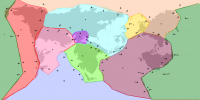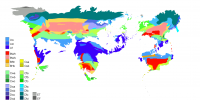Difference between revisions of "Aravala"
(→Plate tectonics) |
|||
| (5 intermediate revisions by the same user not shown) | |||
| Line 6: | Line 6: | ||
| image = File:Aravala globe.png | | image = File:Aravala globe.png | ||
| image_alt = Drawing of Aravala, after the famous picture by SNTL Cosmonauts in 1975 Showing the Centrall Archipelago in the middle and the Old Continent on the left, and the Newland in the far right. | | image_alt = Drawing of Aravala, after the famous picture by SNTL Cosmonauts in 1975 Showing the Centrall Archipelago in the middle and the Old Continent on the left, and the Newland in the far right. | ||
| − | | caption = The most widely used | + | | caption = The most widely used picture of Aravala, after the famous picturetaken by SNTL Cosmonauts in 1975 |
| epoch = | | epoch = | ||
| aphelion = 152,100,000 km | | aphelion = 152,100,000 km | ||
| Line 90: | Line 90: | ||
[[File:Aravala winkel-tripel.png|200px|thumb|left|Aravala winkel-tripel]] | [[File:Aravala winkel-tripel.png|200px|thumb|left|Aravala winkel-tripel]] | ||
| − | Map of Aravala shown in Winkel-Tripel projection. | + | Map of Aravala shown in Winkel-Tripel projection. Alternate projection (equirectangular) can be seen here: [[media:Aravala_english.png]] |
The shape of Aravala is nearly spherical. There is a small flattening at the poles and equatorial bulge around the equator due to Aravala's rotation, therefore, a better approximation of Aravala's shape is an oblate spheroid, whose equatorial diameter is {{convert|43|km|mi}} larger than the Geographical pole-to-pole diameter. | The shape of Aravala is nearly spherical. There is a small flattening at the poles and equatorial bulge around the equator due to Aravala's rotation, therefore, a better approximation of Aravala's shape is an oblate spheroid, whose equatorial diameter is {{convert|43|km|mi}} larger than the Geographical pole-to-pole diameter. | ||
| Line 116: | Line 116: | ||
[[File:Aravala 0.4 köppen 2.png|200px|thumb|left|Köppen Climate classification of Aravala]] | [[File:Aravala 0.4 köppen 2.png|200px|thumb|left|Köppen Climate classification of Aravala]] | ||
| − | The climate model map of Aravala showing the [[Köppen climate classification]] regions of Aravala. The Köppen climate classification scheme divides climates into five main climate groups: ''A'' (tropical), ''B'' (dry), ''C'' (temperate), ''D'' (continental), and ''E'' (polar). The second letter indicates the seasonal precipitation type, while the third letter indicates the level of heat. Summers are defined as the 6-month period that is warmer either from April–September and/or October–March while winter is the 6-month period that is cooler. | + | The climate model map of Aravala showing the [[Köppen climate classification]] regions of Aravala. The Köppen climate classification scheme divides climates into five main climate groups: ''A'' (tropical), ''B'' (dry), ''C'' (temperate), ''D'' (continental), and ''E'' (polar). The second letter indicates the seasonal precipitation type, while the third letter indicates the level of heat. Summers are defined as the 6-month period that is warmer either from April–September and/or October–March while winter is the 6-month period that is cooler. Listed here are those major climate types that are present in the map. The local variation varies considerably. |
| + | |||
| + | '''Group A: Tropical Climates''' | ||
| + | |||
| + | *''Af'' - Tropical rain-forest climate | ||
| + | *''Am'' - Tropical monsoon, or seasonal climate | ||
| + | *''As'' and ''Aw'' - Tropical savanna climate | ||
| + | |||
| + | '''Group B: Dry climates''' | ||
| + | |||
| + | *''BWh'' - Hot desert climate | ||
| + | *''BWk'' - Cold desert climate | ||
| + | *''BSh'' - Hot semi-arid climate | ||
| + | *''BSk'' - Cold semi-arid climate | ||
| + | |||
| + | '''Group C: Temperate climates''' | ||
| + | |||
| + | *''Cfa'' - Humid subtropical climate | ||
| + | *''Cfb'' - Temperate oceanic climate | ||
| + | *''Cfc'' - Sub-polar oceanic climate | ||
| + | *''Cwa'' - Monsoon inflicted humid subtropical climate | ||
| + | *''Cwb'' - Subtropical highland climate or Monsoon-influenced temperate oceanic climate | ||
| + | *''Cwc'' - Cold subtropical highland climate or Monsoon-influenced subpolar oceanic climate | ||
| + | *''Csa'' - Hot summer Hot-summer Mediterranean climate | ||
| + | *''Csb'' - Warm-summer Mediterranean climate | ||
| + | |||
| + | '''Group D: Continental climates''' | ||
| + | |||
| + | *''Dfa'' - Hot-summer humid continental climate | ||
| + | *''Dfb'' - Warm-summer humid continental climate | ||
| + | *''Dfc'' - Subarctic climate | ||
| + | *''Dwa'' - Monsoon-influenced hot-summer humid continental climate | ||
| + | *''Dwb'' - Monsoon-influenced warm-summer humid continental climate | ||
| + | *''Dwc'' - Monsoon-influenced subarctic climate | ||
| + | |||
| + | '''Group E: Polar climates''' | ||
| + | |||
| + | *''ET'' - Tundra | ||
| + | *''EF'' - Ice Cap | ||
| + | |||
| + | |||
| + | |||
| + | |||
| + | [[File:Aravala 0.4.1 biomit.png|200px|thumb|left|Major Biomes of Aravala]] | ||
==Continents== | ==Continents== | ||
| + | |||
| + | [[File:Aravala countries.png|200px|thumb|left|Aravala country division]] | ||
| + | |||
| + | A Map of 2021 showing the over 130 countries making up the Aravalas globe. [[Media:Aravala 1.0 valtiot.png]] Shows the more detailed version with individual countries named. | ||
| + | |||
| + | |||
[[Category:Aravala]][[Category:Universes]] | [[Category:Aravala]][[Category:Universes]] | ||
Latest revision as of 16:35, 1 September 2021
 The most widely used picture of Aravala, after the famous picturetaken by SNTL Cosmonauts in 1975 | |||||||||||||
| Designations | |||||||||||||
|---|---|---|---|---|---|---|---|---|---|---|---|---|---|
| Earth, World, Maa, Maapallo, Daellak | |||||||||||||
| Adjectives | Aravalanian | ||||||||||||
| Orbital characteristics | |||||||||||||
| Aphelion | 152,100,000 km | ||||||||||||
| Perihelion | 147,095,000 km | ||||||||||||
| 149,598,023 km | |||||||||||||
| Eccentricity | 0.0167086 | ||||||||||||
| 365.256363004 d | |||||||||||||
Average orbital speed | 29.78 km/s | ||||||||||||
| 358.617° | |||||||||||||
| Inclination | 7.155 ° to the Sun 's equator ; 1.57869 ° to invariable plane ; 0.00005° to J2000 | ||||||||||||
| -11.26064 ° to J2000 ecliptic | |||||||||||||
| 2021-Jan-02 13:59 | |||||||||||||
| 114.20783 ° | |||||||||||||
| Satellites |
| ||||||||||||
| Physical characteristics | |||||||||||||
Mean radius | 6371.0 km | ||||||||||||
Equatorial radius | 6378.137 km | ||||||||||||
Polar radius | 6356.752 km | ||||||||||||
| Flattening | 1/ 298.257222101 VMplRS93 | ||||||||||||
| Circumference |
| ||||||||||||
| |||||||||||||
| Volume | 1.08321 e=12km3 | ||||||||||||
| Mass | 5.97237 e=24kg | ||||||||||||
Mean density | 5.514 g/cm3 | ||||||||||||
| 9.80665 m/s2 | |||||||||||||
| 0.3307 | |||||||||||||
| 11.186 km/s | |||||||||||||
Sidereal rotation period | 0.99726968 d | ||||||||||||
Equatorial rotation velocity | 1674.4 km/h | ||||||||||||
| 23.4392811° | |||||||||||||
| Albedo | 0.367 Geometric albedo 0.306 Bond albedo | ||||||||||||
| |||||||||||||
| Atmosphere | |||||||||||||
Surface pressure | 101.325 kPa (at Sea level ) | ||||||||||||
| Composition by volume |
| ||||||||||||
Etymology
The name Aravala Is not used as name for the Planet, but the local inhabitants call it simply as planet earth, or Maa , Maapallo In Evoan language. Aravala Is included as a name, to separate it from the world of the viewer. The Term Aravala appear in Evoan Religious concepts as Otherworldly afterlife, where the Gods and spirits dwells, and is in some sources described to include alternate worlds, therefore is been chosen to be used as the describing and Defining term when used in our world.
Geography
Main article: Geography of Aravala, Aravala
Map of Aravala
Map of Aravala shown in Winkel-Tripel projection. Alternate projection (equirectangular) can be seen here: media:Aravala_english.png
The shape of Aravala is nearly spherical. There is a small flattening at the poles and equatorial bulge around the equator due to Aravala's rotation, therefore, a better approximation of Aravala's shape is an oblate spheroid, whose equatorial diameter is 43 kilometres (27 mi) larger than the Geographical pole-to-pole diameter.
The average diameter of the reference spheroid is 12,742 kilometres (7,918 mi). Local topography deviates from this idealized spheroid, although on a global scale these deviations are small compared to Aravala's radius: the maximum deviation of only 0.17% is at the Oipaal Trench (10,945 metres or 35,909 feet below local sea level), In geodesy, the exact shape that Aravala's oceans would adopt in the absence of land and perturbations such as tides and winds is called the geoid. More precisely, the geoid is the surface of gravitational equipotential at mean sea level are water deviations from MSL, analogous to land topography.
Plate tectonics
The Aravala's litosphere is divided into 10 major tectonic plates, which movements and directions are visualized in this simplified graph. In Addition many minor plates exist. Where the plates meet, their relative motion determines the type of boundary: convergent, divergent, or transform. Earthquakes, volcanic activity, mountain-building, and oceanic trench formation occur along these plate boundaries (or faults). The relative movement of the plates typically ranges from zero to 100 mm annually. Due to the International Geopolitical and ideological differences, the scientific community has not reached in conclusion in many terms, including naming the major tectonic plates. In here is presented the KaMaY Kansainvälinen Maantieteellinen Yhteisö - International Geographic Society - from the Socialistic Blocs scientific community's classification of the plates:
- The Last Ocean plate, which moves away from Saa's plate and towards the Uusimaa and Anadak plates
- Saa's Plate, moving towards the converging Rim and Old World plate that causes the great mountain formations in the center of the Old Continent
- Rim's Plate
- Old Continent Plate, or Eastern Plate
- Mahathamalan Plate
- Rovintala's Plate
- Silver Plate
- Uusimaa's Plate
- Southern Plate
Climate
The climate model map of Aravala showing the Köppen climate classification regions of Aravala. The Köppen climate classification scheme divides climates into five main climate groups: A (tropical), B (dry), C (temperate), D (continental), and E (polar). The second letter indicates the seasonal precipitation type, while the third letter indicates the level of heat. Summers are defined as the 6-month period that is warmer either from April–September and/or October–March while winter is the 6-month period that is cooler. Listed here are those major climate types that are present in the map. The local variation varies considerably.
Group A: Tropical Climates
- Af - Tropical rain-forest climate
- Am - Tropical monsoon, or seasonal climate
- As and Aw - Tropical savanna climate
Group B: Dry climates
- BWh - Hot desert climate
- BWk - Cold desert climate
- BSh - Hot semi-arid climate
- BSk - Cold semi-arid climate
Group C: Temperate climates
- Cfa - Humid subtropical climate
- Cfb - Temperate oceanic climate
- Cfc - Sub-polar oceanic climate
- Cwa - Monsoon inflicted humid subtropical climate
- Cwb - Subtropical highland climate or Monsoon-influenced temperate oceanic climate
- Cwc - Cold subtropical highland climate or Monsoon-influenced subpolar oceanic climate
- Csa - Hot summer Hot-summer Mediterranean climate
- Csb - Warm-summer Mediterranean climate
Group D: Continental climates
- Dfa - Hot-summer humid continental climate
- Dfb - Warm-summer humid continental climate
- Dfc - Subarctic climate
- Dwa - Monsoon-influenced hot-summer humid continental climate
- Dwb - Monsoon-influenced warm-summer humid continental climate
- Dwc - Monsoon-influenced subarctic climate
Group E: Polar climates
- ET - Tundra
- EF - Ice Cap
Continents
A Map of 2021 showing the over 130 countries making up the Aravalas globe. Media:Aravala 1.0 valtiot.png Shows the more detailed version with individual countries named.




